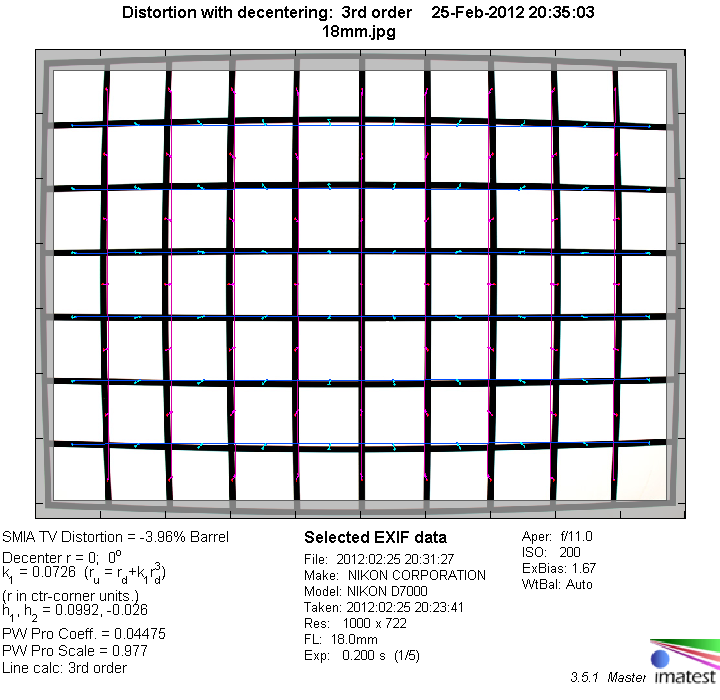|
Page 2 of 2

Distortion
Typical for extreme range zooms the Tamron exhibits a fairly hefty amount of barrel distortion at 18mm (almost 4%). However, beyond the wide end the problem is actually quite well controlled for a super-zoom lens with moderate pincushion distortion. These can still be disturbing especially for subjects with straight lens near the image borders, but we have seen worse values from similar lenses in this regard.
|
Move the mouse cursor over the focal length text marks below to observe the respective distortion
|
| 18mm |
35mm |
80mm |
130mm |
270mm |
|

|
The chart above has a real-world size of about 120x80cm.
Vignetting
The Tamron is a dedicated DX lens but despite the ambitious design vignetting is comparatively well controlled, except the largest aperture setting at 18mm and the very long end of the zoom range. In critical situations it already helps to stop down a little (just a stop).

MTF (resolution)
The predecessor of the 18-270mm VC, the 18-250mm, came up with surprisingly high resolution numbers in our initial lab tests, but these tests were based on 8mp (Canon) and 10mp (Nikon) test bodies. The situation is a little different now on the 16 MP D7000, where the 18-270mm VC struggles somewhat to impress. At 18mm and 35mm the lens is able to deliver a generally decent quality with an extremely sharp center and acceptable borders, at least when stopped down. At 80mm the maximum resolution drops across the frame for all tested apertures, but nonetheless the lens is able to deliver "very good" resolution here when stopped down to f/8. At longer focal lengths the center resolution drops even more, still reaching "very good" numbers at 130mm but only "good" results at 270mm. At both settings the borders and corners deliver quite soft results. At 270mm, even stopping to f/11 does not help to reach better than just "fair" sharpness here.
The (focus-)field curvature is very low. Just like the Canon mount version of the lens we tested earlier, the centering quality of the tested sample was generally good but it deteriorated somewhat at and beyond 200mm (not unusual for lenses with image stabilization).
Please note that the MTF results are not directly comparable across the different systems!
Below is a simplified summary of the formal findings. The chart shows line widths per picture height (LW/PH) which can be taken as a measure for sharpness.
If you want to know more about the MTF50 figures you may check out the corresponding Imatest Explanations

Chromatic Aberrations (CAs)
In the lower and medium part of the zoom range the lateral CAs (color shadows at harsh contrast transitions) are relatively well controlled with values up to roughly 2px at the image borders. However, towards the maximum focal length of 270mm the problem gets very pronounced with CAs reaching almost 3.5 px here.
However, CAs can easily be corrected in software or by the camera itself (most modern Nikon DSLRs remove CAs themselves if you shoot JPGs).

Sample Shots
Unfortunately the weather did not allow to shoot usable sample images during the time the lens was available for testing. However, full resolution sample images are available in our review of the Canon mount version of this lens.
Verdict
Just like the rest of its (extreme zoom range) lens species the Tamron AF 18-270mm f/3.5-6.3 Di LD Aspherical [IF] VC macro (sorry, I had to repeat that again ...) tries to provide it all, but the continuously higher degree of generalization rather than specialization has a price - image quality. The lens had a bit of a hard time to deliver a good image quality on a high resolution DSLR. The center performance is generally decent but the border quality could/should be better especially at large aperture settings. The long end of the zoom range does also suffer from rather hefty lateral CAs (color shadows) which doesn't really help to lift the quality perception here.
The amount of image distortion it quite typical for this kind of lens: hefty barrel distortion at 18mm but actually a pretty decent correction at all other settings (for a super zoom). The vignetting is, surprisingly, a lesser issue although you may spot some hints at max. aperture settings.
The build quality is generally Ok but it's nothing to rave about either. The AF left us with mixed feelings, especially because of its lack of precision. Tamron's VC systems works as promised and is about as good as competing image stabilization systems.
So, a quite mixed performance, as it is typical for many super-zooms. The lens' biggest value is no doubt the large zoom range and thus convenience. But as with almost any other extreme zoom lens: if you're looking for high image quality rather than convenience you should look elsewhere.
|